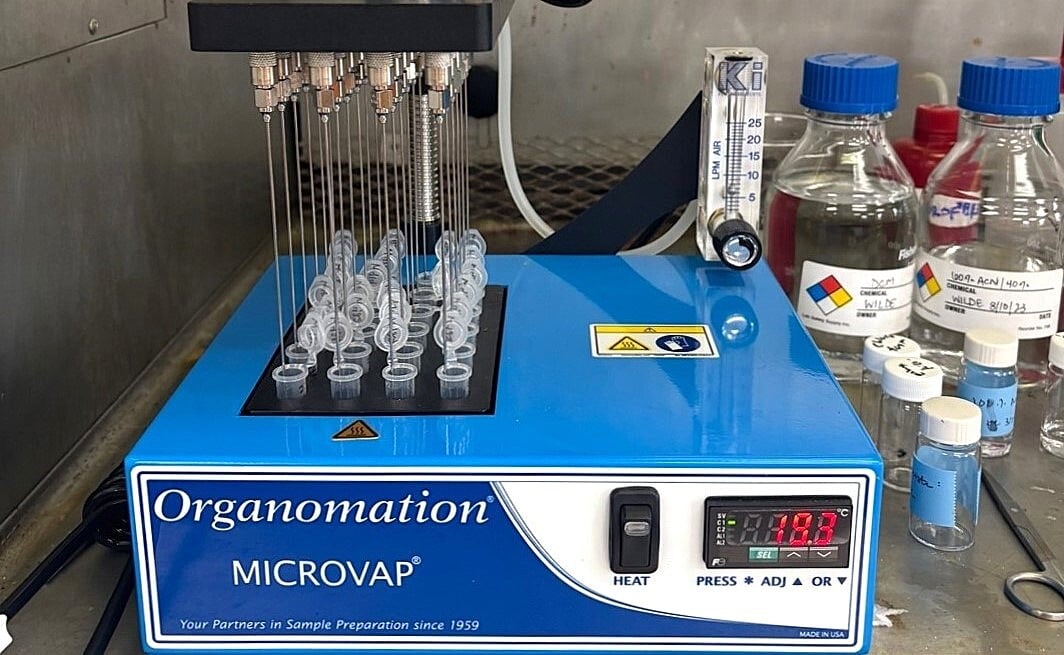
How a Lab Studying the "Eagle Killer" Streamlined Sample Prep with One Switch
At the University of Georgia, Dr. Susan Wilde’s lab is leading crucial research into Vacuolar Myelinopathy (VM)—a fatal neurological disease linked to the cyanobacterial neurotoxin Aetokthonotoxin (AETX). This toxin, produced by Aetokthonos hydrillicola, has caused widespread mortality in bald eagles and other species across the southeastern United States. The Wilde Lab’s mission is to better understand AETX’s role in this disease and improve detection methods for the toxin in both environmental and biological samples.
To do this, the team is adapting the widely used AOAC 2007.01 QuEChERS extraction method to effectively capture AETX while removing co-extracted lipids and proteins from sample types such as plant material, eggs, fish tissue, and animal organs. The workflow includes multiple evaporation and drying steps to concentrate the analyte before final analysis by LC-MS/MS or Orbitrap analysis.
By refining this established method for AETX-specific workflows, the lab aims to increase efficiency and reproducibility, reduce their reliance on external labs by bringing the process in-house, and ultimately deliver faster, more cost-effective results to federal, state, and local stakeholders involved in environmental monitoring and wildlife conservation.
Challenge: A Homemade Evaporator Slowing Down Sample Prep.jpeg?width=512&height=318&name=71736271887__6AC58BC6_D62F_417F_9824_860E04D0D636%20(1).jpeg)
Before upgrading to professional equipment, the Wilde Lab relied on a DIY evaporation setup cobbled together from aquarium tubing, pipet tips, and plenty of duct tape. While impressively inventive, the setup was far from ideal. It lacked consistency, required constant maintenance, and often took one to two hours to fully dry down samples—especially when nitrogen gas wasn’t available and the team had to rely on forced air alone. The setup became a shared source of frustration and pride within the lab.
"One particular piece of said "equipment" (if you could even call it) is our very creatively homemade evaporator. Real scientific breakthroughs were achieved while using this contraption, and five very accomplished students (three PhD and two MS) will have graduated this summer having used, broken, repaired, taped and re-taped the beloved homemade evaporator." —Katy Callaghan, Lab Manager
Despite the ingenuity behind it, the makeshift evaporator had become a bottleneck in the lab’s workflow. As research demands grew and LC-MS/MS analysis became more central to their work, it was clear the team needed a more efficient, durable, and space-saving solution—one that could improve evaporation consistency, reduce prep time, and keep pace with their expanding toxin detection efforts.
Solution: The 24-Position MICROVAP Nitrogen Evaporator
Katy Callaghan entered the lab’s homemade evaporation setup into Organomation’s inaugural Homemade Evaporator Contest, showcasing the team’s resourcefulness and need for a more professional system. Thanks to the ingenuity of their design—and the clear impact a proper upgrade would have on their workflow—the Wilde Lab was awarded the grand prize: a brand-new 24-position MICROVAP, purpose-built for small-volume, parallel sample evaporation.
Since integrating the MICROVAP into their workflow, the lab has seen substantial improvements:
- Reduced evaporation times by 35-40%: Even without heat, 1.5 mL of dichloromethane now evaporates in just 28 minutes, and 100 μL of acidified acetonitrile dries down in only 9 minutes. What once took up to two hours now takes just over half an hour. And with plans to explore the unit’s heated dry block, the lab anticipates even greater time savings ahead.
- Improved parallel sample capacity: The MICROVAP accommodates 24 samples at once, perfectly aligning with the lab’s vortex adapter and centrifuge setup—allowing for seamless batch processing.
- Enhanced reproducibility and safety: The concentrated nitrogen flow and durable stainless steel needles have greatly improved consistency while eliminating leaks common with their old tubing-based system.
- Reclaimed fume hood space: The MICROVAP’s compact footprint has freed up critical fume hood space, supporting a more efficient lab environment.


“The difference in using the Organomation MICROVAP versus our homemade “contraption” has been night-and-day! It takes significantly less time to dry samples, as the flow of nitrogen is highly concentrated and does not allow for any leaks in tubing like our previous “contraption” made out of aquarium tubing and pipet tips", said Katy. "It is much more compact than our previous system, so it leaves much more space in the fume hood for other equipment."
One especially valuable feature is the non-plastic steel needles, which prevent AETX—a notoriously sticky compound—from binding to surfaces. The team also appreciates how the stainless steel needles are easier to clean, more durable, and longer lasting.
Results: Increased Efficiency and In-House Capability
With the MICROVAP in use, the Wilde Lab is now more equipped than ever to deliver timely, high-quality toxin data to local, state, and federal partners. The lab is also well on its way to becoming self-sufficient in sample analysis, eliminating bottlenecks caused by equipment sharing or outsourcing.
“The students and staff of Dr. Susan Wilde’s “Wilde Lab” at the University of Georgia has greatly benefitted from the addition of an Organomation MICROVAP to our fleet of laboratory instruments. Receiving a brand-new MICROVAP from Organomation has made a huge difference in our ability to quickly and reliably process a wide array of samples for local, state and federal partners, and is a major stride towards our plan to conduct all components of sample analyses in-house at the University of Georgia."
Are you still using a homemade evaporator for your sample evaporations? Not sure if it makes sense to upgrade? Read our article on when you should swap your DIY sample evaporator for a professional dryer system.
See how much time you could save by switching to a nitrogen evaporator:
